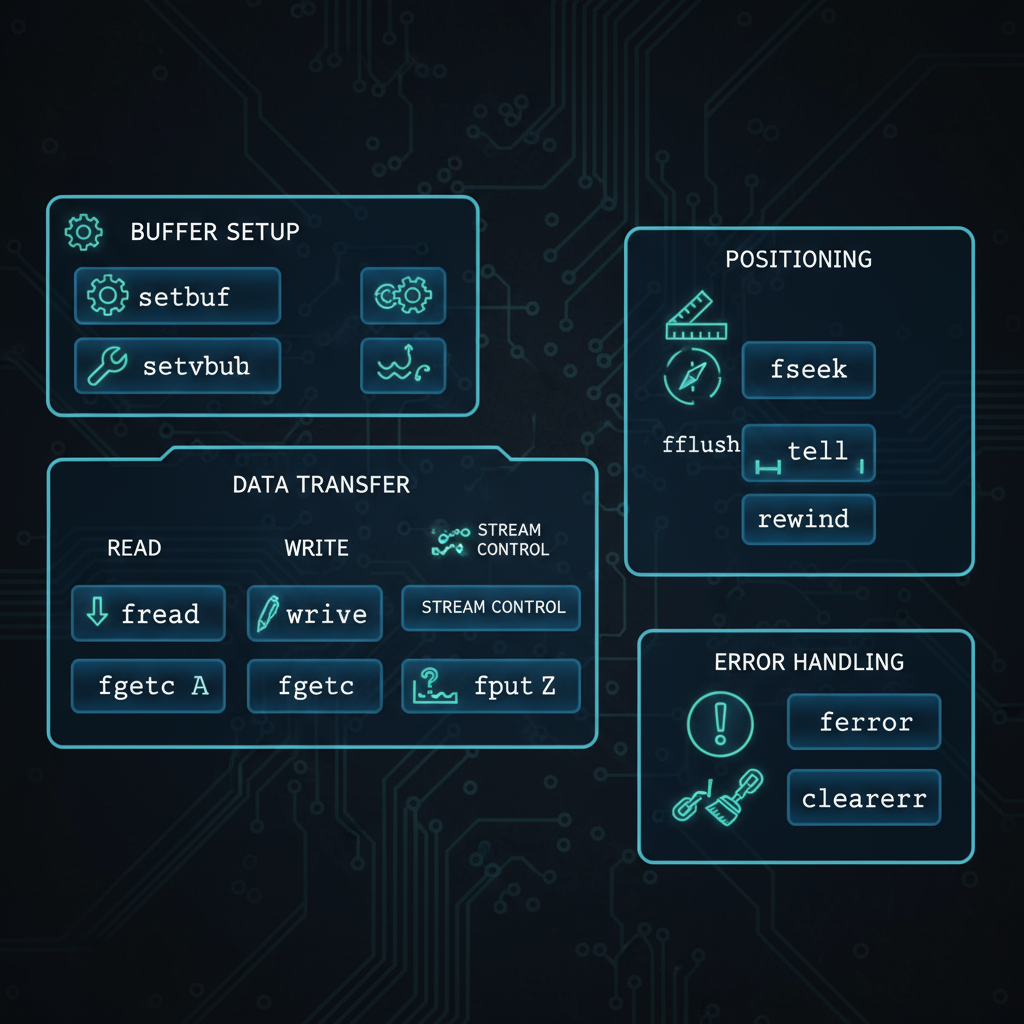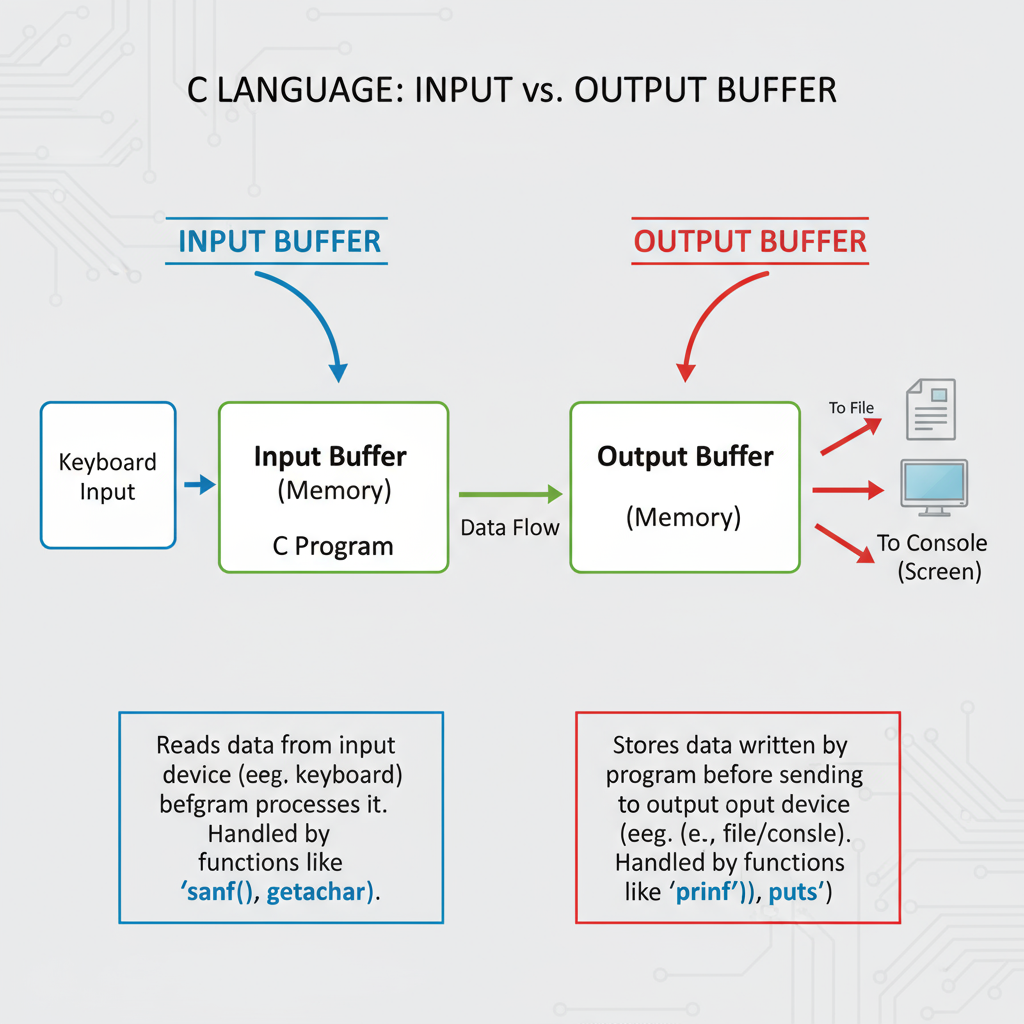Buffer in C Programming Explained with Examples and Uses
Learn how buffers work in C programming, including input and output types, buffered I/O with stdio, and static vs dynamic allocation examples.

Introduction to Buffers in C Programming
In C programming, buffers are fundamental memory structures that temporarily store data during transfer between two locations, such as from disk to memory or from memory to a network socket. Proper buffer management helps improve performance, reduce direct I/O operations, and enable batch processing. Understanding buffers in C is essential for smooth data handling, fast I/O, and secure code, particularly in applications involving networking or large file operations.
Buffers:
- Smooth data flow by holding information before processing.
- Reduce the cost of frequent read/write calls.
- Facilitate efficient computation on larger data chunks.

For instance, reading a file character-by-character is inefficient; using a buffer to read chunks of data into memory and process them there greatly optimizes the program.
---
Difference Between Input Buffer and Output Buffer
In C, buffers are generally classified into two main types:
Input Buffer
- Stores incoming data from a source (keyboard, file, network) before it is processed.
- Example: When typing characters in a terminal, characters go into an input buffer before the program reads them.
Output Buffer
- Holds data to be sent to an output device (screen, file, network) until flushing occurs.
- Example: Standard output via `printf()` usually stores text in an output buffer before rendering it on the console.
| Buffer Type | Purpose | Example |
|---|---|---|
| Input Buffer | Receive and store raw incoming data | Keyboard input waiting in stdin |
| Output Buffer | Store data before sending to output | printf() output pending in stdout |
---
How Data Buffering Works in C with stdio Streams
The `stdio.h` library provides buffered I/O through three standard streams:
- `stdin` – standard input
- `stdout` – standard output
- `stderr` – standard error (often unbuffered)
Buffered I/O Mechanism
- Read/write operations occur on a temporary memory area (the buffer).
- Input buffers hold characters until the program consumes them.
- Output buffers accumulate data until capacity or explicit flush.

Buffering reduces expensive read/write calls to slow hardware, increasing throughput.
---
Common Buffer Handling Functions in C
Several functions are key to using buffers:
Input
- `fgets()` – Safely reads a limited number of characters from `stdin`.
- `scanf()` – Reads formatted data into variables; requires careful format specifiers.
- `gets()` – Deprecated and unsafe; avoid using.
Output
- `printf()` – Writes formatted output to `stdout`.
- `fprintf()` – Writes formatted output to a specified file stream.
---
Static vs Dynamic Buffers
Buffers can be allocated at compile time or runtime:
Static Buffers
- Declared with fixed size (arrays).
- Faster allocation, but inflexible size.
Dynamic Buffers
- Allocated at runtime with `malloc()` or `calloc()`.
- Adjustable size; requires manual memory management.
| Method | Allocation Time | Advantages | Disadvantages |
|---|---|---|---|
| Static Buffer | Compile time | Simple, fast allocation | Fixed size, possible wasted memory |
| Dynamic Buffer | Run time | Adjustable size at runtime | Requires manual memory management |
---
Examples: Reading Data into a Buffer
Safe input using `fgets`:
#include
int main() {
char buffer[50];
printf("Enter text: ");
if (fgets(buffer, sizeof(buffer), stdin)) {
printf("You entered: %s", buffer);
}
return 0;
}Using `scanf` with bounds:
#include
int main() {
char buffer[20];
printf("Enter a word: ");
scanf("%19s", buffer);
printf("Word: %s\n", buffer);
return 0;
}---
Writing a Buffer to a File or Stream
#include
int main() {
char buffer[] = "Hello, buffer!";
FILE *fp = fopen("output.txt", "w");
if (fp) {
fputs(buffer, fp);
fclose(fp);
}
return 0;
}Useful for logging, saving results, or transferring data to output devices.
---
Buffer Overflow Risks and Prevention
A buffer overflow occurs when data writes exceed a buffer’s capacity, corrupting memory.
Risks include:
- Program crashes
- Security vulnerabilities
- Data loss
To prevent:
- Enforce buffer size limits.
- Prefer safe functions (`fgets`, `snprintf`).
- Avoid unsafe functions like `gets`.
---
Implementing Safe Buffers with strncpy
#include
#include
int main() {
char source[] = "Safe buffer copy example";
char dest[10];
strncpy(dest, source, sizeof(dest) - 1);
dest[sizeof(dest) - 1] = '\0';
printf("Destination: %s\n", dest);
return 0;
}---
Circular Buffers: Concept and Use Cases
A circular buffer treats a fixed-size memory as looping from end back to start.
Applications
- Audio streaming
- Network packet queues
- Real-time sensor data
Basic Implementation
#define SIZE 5
int buffer[SIZE];
int head = 0, tail = 0;
void write_data(int data) {
buffer[head] = data;
head = (head + 1) % SIZE;
}
int read_data() {
int data = buffer[tail];
tail = (tail + 1) % SIZE;
return data;
}
---
Flushing Buffers with fflush()
`fflush()` forces immediate writing of buffered data:
#include
int main() {
printf("Immediate output");
fflush(stdout);
return 0;
}Frequent manual flushing can harm performance; use when timely output is critical.
---
Real-World Buffer Applications in C
- Handling large file reads/writes
- Networking protocol implementation
- Streaming media for smooth playback
- Processing sensor input streams
---
Best Practices for Buffer Management
- Allocate buffers to handle worst-case data sizes.
- Use safe input/output functions.
- Initialize buffers.
- Monitor buffer usage for performance tuning.
- Free dynamically allocated buffers promptly.
---
Summary and Next Steps
Buffers in C enable efficient and secure data handling across input/output operations, file processing, and network communications. By mastering buffer allocation, usage, and protection techniques, you can avoid pitfalls like overflow and achieve high performance in your programs.
Start applying these C buffer strategies today to improve your application speed and reliability.




